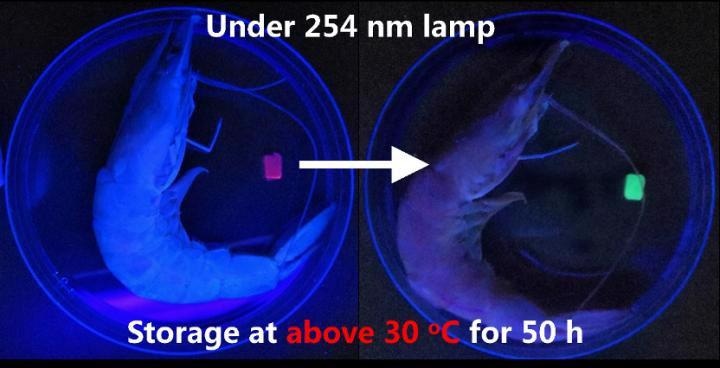May 7 2021
A team of researchers from Germany and China has developed a novel artificial color-changing material that imitates the skin of a chameleon, through luminogens (molecules that cause crystals to glow) arranged into different core and shell layers of hydrogels rather than a single uniform matrix.
 This image shows the color change of the “chameleon skin” hydrogel-based chemosensor in response to biogenic volatile amine vapors, which are a well-known indicator of fish and shrimp spoilage. Image Credit: Lu et al./Cell Reports Physical Science.
This image shows the color change of the “chameleon skin” hydrogel-based chemosensor in response to biogenic volatile amine vapors, which are a well-known indicator of fish and shrimp spoilage. Image Credit: Lu et al./Cell Reports Physical Science.
The results, recently published in the Cell Reports Physical Science journal on May 6th, 2021, demonstrated that a two-luminogen hydrogel chemosensor fabricated with this novel design can detect the freshness of seafood by altering color in response to amine vapors produced by microorganisms when fish spoils.
The new material could even be used to improve the development of anti-counterfeiting technologies, dynamic camouflaging robots, and stretchable electronics.
This novel core-shell layout does not require a careful choice of luminogen pairs, nor does it require an elaborate design and regulation of the complex photophysical interactions between different luminogens. These advantages are important to the future construction of robust multicolor material systems with as-yet-unachieved performance.
Tao Chen, Study Author and Professor, Ningbo Institute of Materials Technology and Engineering, Chinese Academy of Sciences
For a long time, investigators have been aiming to develop soft materials that can easily change between a broad range of fluorescent colors, but synthetic materials can hardly change color as ingeniously as chameleons do.
Most artificial color-changing soft materials have been prepared by simultaneously incorporating two or more responsive luminogens into one single elastomer or hydrogel matrix. On the other hand, the organization of different iridophores into two superposed core-shell structured layers constitutes an evolutionary novelty for panther chameleons that allows their skins to display complex structural colors.
Tao Chen, Study Author and Professor, Ningbo Institute of Materials Technology and Engineering, Chinese Academy of Sciences
Subsequently, Wei Lu, a researcher from the Ningbo Institute of Materials Technology and Engineering at the Chinese Academy of Sciences, and collaborators designed a multi-luminogen-layered hydrogen system from the inside out. This was done to find out whether there it was viable to infuse the artificial color-changing materials with the natural core-shell structure of the skin of chameleon.
The team initially produced a red fluorescent core hydrogel, which would act as a template for the other layers. The fluorescent core hydrogel was incubated in different aqueous Europium solutions, and the gel was then incubated in a growth solution comprising responsive blue/green fluorescent polymers and sodium alginate.
When the Europium ions spontaneously diffused from the fluorescent core hydrogel into the surrounding solution, it resulted in the formation of blue and green hydrogel layers.
The overlapping of the core and shell layers of the hydrogels may cause them to change from red to green or blue color when triggered by pH or temperature changes. The researchers also observed that the emission color of the green and blue fluorescent layers can possibly be modified, allowing the material to show colors from almost the entire visible spectrum.
The proposed diffusion-induced interfacial polymerization to prepare core-shell materials proves to be general. It is thus highly expected that the proposed synthetic strategy could be expanded to produce other soft color-changing materials, such as smart hydrogels or elastomers with stimuli-responsive structural color or pigment color change.
Tao Chen, Study Author and Professor, Ningbo Institute of Materials Technology and Engineering, Chinese Academy of Sciences
According to Chen, the new core-shell hydrogels, as well as the diffusion-induced interfacial polymerization technique used to make these hydrogels, may prove handy in many different scientific domains, including robotics.
“In the near future, we plan to utilize the developed chameleon skin-like core-shell hydrogels to prepare biomimetic soft camouflaging skins, which can be used to mimic the diverse color-changing functions of living organisms’ skins and to help achieve desirable active camouflage, display, and alarm functions in robots,” concluded professor Chen.
The study was funded by the National Natural Science Foundation of China, the Sino-German Mobility Program, the Key Research Program of Frontier Sciences, Chinese Academy of Sciences, the Youth Innovation Promotion Association of Chinese Academy of Sciences, and the Open Fund of the Guangdong Provincial Key, Laboratory of Luminescence from Molecular Aggregates, South China University of Technology.
Journal Reference:
Lu, W., et al. (2021) A panther chameleon skin-inspired core@shell supramolecular hydrogel with spatially organized multi-luminogens enables programmable color change. Cell Reports Physical Science. doi.org/10.1016/j.xcrp.2021.100417.